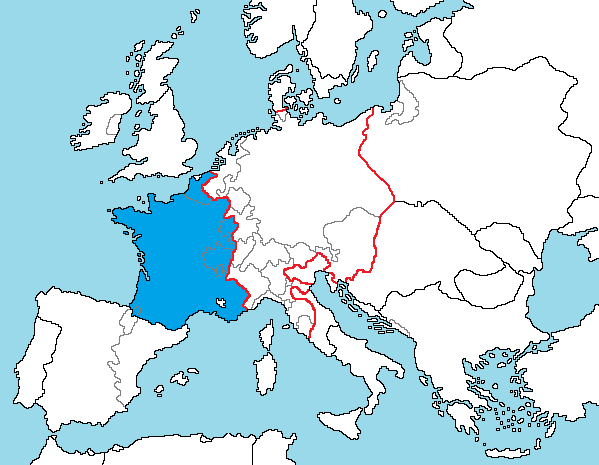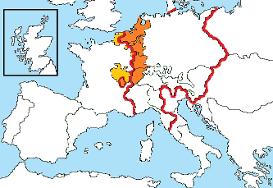France in 1525

French Territory in 1525
- Red line indicates the boundary of the Holy Roman Empire

The Division of Burgundy
- Orange - Burgundian lands retained by the House of Hapsburg.
- Yellow - Burgundian lands annexed by the French Crown.
- Red line - boundary of The Holy Roman Empire.
The French victory in the Hundred Years War [1337-1453] drove the English out of France's western provinces of Normandy, Gascony and Anjou. However France's wars with the Holy Roman Empire continued for another 300 years and only ended when Napoleon conquered and dissolved her ancient enemy in the east.
The principle bone of contention was the French king's historic claims to Italy and the semi-independent dukedom Burgundy. Though the Dukes of Burgundy were descended from the Valois kings of France, they made frequent war on their French cousins as they extended their territory. By the middle of the 15th Century the Dukes of Burgundy were as powerful as any monarch in Europe and they ruled a vast swathe of territory that stretched from the Swiss Alps to The Low Countries.
In 1477, after the death in battle of of the last independent Duke of Burgundy Charles the Bold, the French king Louis XI annexed the Burgundian heartlands to the French crown but the Holy Roman Emperor Maximilian I also claimed the Duchy by virtue of his marriage to Charles the Bold's daughter Mary.
Maximilian refused to relinquish control of The Low Countries, Lorraine, Franche-Comte and the enclave of Charolais and to further complicate the Burgundian succession, Mary's mother (Margaret of Burgundy) was sister to England's deposed Yorkist king Richard III.
France's struggles in Burgundy were repeated further south when, in an attempt to stem the growing tide of Hapsburg power, three kings of France revived their tenuous claims to Kingdoms of Naples and Sicily and the Duchy of Milan. These territories were controlled by the Holy Roman Empire and the French claims precipitated The Italian Wars [1494-1559].
Successive generations of French Valois kings (Charles VIII, Louis XII and Francis I) therefore crossed The Alps to do battle with the Austro-Spanish Hapsburg Holy Roman Emperors (Maximilian I and Charles V) and these campaigns culminated in the pivotal Battle of Pavia [1525].